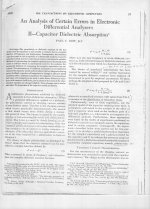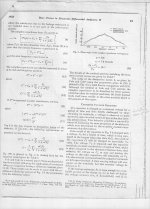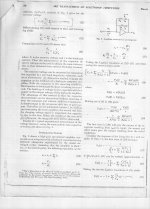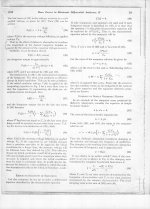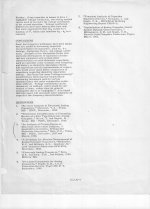Proprioception is learned, we all take practice to learn how to walk and to put food into our mouths and not our ears....I take it you are witnessing this servo positioning learning/calibration process close up.
I’ve noticed that after heavy boozing, the action of walking and spoon steering can be severely dis-coordinated.
What is going wrong?
Is it the memory of the learned practice that is temporary lost or is it the sensory-motional feedback somewhere compromised?
George
My understanding is that the majority of the proprioceptors still work fine, but the ear gets confused and big squishy makes a mess of interpreting it all.
To be honest, we have to take in consideration that, for a given cutoff frequency, the needed capacitance value can be divided by a 100 (or more) factor with a 'servo' and that we can achieve a steeper slope.Of course. It is just not visible at first sight, so it can make a nice story 😉
And that servos can compensate in the same time some DC from the source.
Means we can use capacitors in the same time smaller, cheaper and of better quality.
I believe Richard Marsh is quite aware of what is a servo and a cap, for historical reasons 🙂
Just to keep things is perspective, this was Scott's opinion on DA in the 1980's:
If you can find any difference to what I said the other day please elaborate.
1) Your detractors said the only effect of DA was that when you charge a cap short it and open it again there is a small DC voltage left on it.
2) The purely linear R/C model explains EVERYTHING we measured and the residual DC. In most cases the aberrations are miniscule and my opinion of these articles is not sensationalism but helping users find a cheap ordinary commercial product that works.
3) I offered to write that up (using SPICE to extract the Pease model) and never heard from you or Walt about that again.
Haha, George, you beat me to the punch when I saw Bill's link to the ESA. 🙂
(Gerhard, were/are you involved with LISA?)
(Gerhard, were/are you involved with LISA?)
Last edited:
BTW -- as for how it sounds depends --- some will say compressed, others will notice inter-transient silent is less, others still will notice the thickening of the sound (2H). A lot of the DA magnitude of affect depends on the waveforms and circuit z's as well.
DA has nothing to do with distortion (directly). We measured it, when I realized how easy it was to find caps that reduced the effects to virtually non-existent everyone lost interest. Did you measure it, you keep referring effects of waveforms, etc. I assume you have measured data?
Bob Pease was making integrating A/D's, essentially a DC application, ppm's of phase error at fractions of a Hz translated into missed or added counts. There was no distortion per se in his caps.
There is lots of metadata from users that don't hear any of this, why is that not factored in?
I saw it from my driveway.
Well, I dunno. I hear they used massive amounts of feedback in those rockets. Bit of cheating really.
BTW nice shots of that flat earth disc 😀
Jan
There is lots of metadata from users that don't hear any of this, why is that not factored in?
Maybe because one can't prove a negative with counter examples, and possibly because it's just not something most people happen to hear or happen to listen for. Most people don't notice bad sounding cymbals unless asked to focus attention on it. Smaller aberrations may require more than focusing of attention, such as training and practice. The thing is, people who complain about very small distortion that most other people don't hear are typically complaining about something very small. However, it may seem big to them if they focus a lot of attention on it. Also, with practice, focusing of attention can become more automatic. Then it can be hard not to do it. As Sean Olive once quipped, "Basically, it ruins your life."
One example on the part of a well-known manufacturer: One reason JBL uses trained listeners is because they notice things casual listeners may not notice, at least not consciously. That casual listeners don't notice is not proof problems don't exist.
Bob Pease was making integrating A/D's, essentially a DC application, ppm's of phase error at fractions of a Hz translated into missed or added counts. There was no distortion per se in his caps.
Don't we all agree that some inexpensive caps are fine? It's just that they get expensive and bulky if large capacitance values are needed.
So, sometimes the only reasonably available caps are electrolytic. Didn't Doug Self measure distortion in them, except at below something like 65mV signal level?
Self found that you could stay on the good side of the knee (on a plot of distortion vs frequency), if the capacitance was suitably large compared to the AC ("displacement") signal current through the cap.
How large was large enough? Large enough that
For example: an electrolytic capacitor used for AC coupling an input signal, drives a 1K load. Max input voltage is 20V RMS. Thus Idisplacement = 20mA. For w=62.8 rad/sec, Self's rule gives C > 3.9E-3 farads. Four thousand microfarads.
Notice that the RC timeconstant is monstrously big.
How large was large enough? Large enough that
- [Idisplacement * (1/jwC)] is less than 80 mV.
For example: an electrolytic capacitor used for AC coupling an input signal, drives a 1K load. Max input voltage is 20V RMS. Thus Idisplacement = 20mA. For w=62.8 rad/sec, Self's rule gives C > 3.9E-3 farads. Four thousand microfarads.
Notice that the RC timeconstant is monstrously big.
DA has nothing to do with distortion (directly). We measured it, when I realized how easy it was to find caps that reduced the effects to virtually non-existent everyone lost interest. Did you measure it, you keep referring effects of waveforms, etc. I assume you have measured data?
There is lots of metadata from users that don't hear any of this, why is that not factored in?
I think this subject has been thoroughly discussed over the decades. Let me just add this --->
it is true that DA has nothing to do with distortion - DIRECTLY. Except with polar types. Then you get more 2H.
Indirectly, is the audible effect of the DA when transient, short impulse type signal waveforms are presented. The high speed sampler showed that in direct A-B comparison of the music sample. I figured it was from DA.
The audible descriptions from others being given to caps follows exactly what DA would do. This audibility always decreased when DA decreased. I devised a test circuit to measure DA (published in TAA) using short periods and varying Z load.
With this awareness, I removed the coupling caps in an IC preamp (Crown IC150) and listened.... much clearer. I then replaced with film type... also clearer but not as clear as no coupling cap. I think it was mylar or poly carb.
I then took the popular topology of the day (discrete) and made it a push-pull, dc coupled circuit (1978-79) Sounded even better.
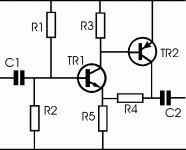 Typical topology of the day.
Typical topology of the day. With that new push-pull config. topology and , low enough gain and stable dc offset (CFA). No servo needed. (Pub 1980 in TAA).
However, high gain stages had dc drift issues (like RIAA) if dc coupled and I had been reading about mechanical servo when the idea to use a dc servo popped into my head. I told Walt Jung he could direct couple if he applied servo idea to his phono circuit. Which he did and published (TAA).
That's the evolution of how we got to accepting balanced, direct-coupled and dc servo to amplifying signals. All from capacitors and their DA's sonic affects and thus desire to eliminate their use.
THx-RNMarsh
Last edited:
And again...
When you have a perfect zero impedance voltage source feeding a perfect resistive load through a capacitor the output voltage is i x R. Lower case is used to represent time varying terms, upper cased fixed ones.
The definition of capacitance is C = q/V or C x V = q.
Taking the first derivative yields C dv/dt + V dc/dt = dq/dt = i.
Thus the output current and resulting voltage is dependent on C not having any changes due to a voltage coefficient AND dv/dt being linear.
The assumption is made that Fourier theory applies stating that all periodic waveforms can be composed of a sum of the sines, and thus linear. Now music is not periodic but the math says that as it is of finite time by setting these limits the signal may be analyzed as periodic. That does work but the lowest frequency of interest then becomes 1/T. That means that a two minute piece of music to be reproduced linearly must have a low frequency response flat to 1/120 cycles per second. Thus confirming Doug Self's observation of capacitor values required.
Now in the case of Dielectric Absorption where you have additional RC time constants the low frequency limit would need to go even lower!!!
Last I looked a milli-farad film capacitor with very low DA could be assembled but was not practical.
Now when you use a capacitor in a servo system it is blocking signal rather than passing it. IE it is a storage device. As a result DA would work to advantage.
Now as RNM has pointed out avoiding the use of coupling capacitors is easy. As the servo only needs to look at very long term DC offset it has little contribution to the signal path. Of course even a servo can be eliminated with a trim mechanism. One of my designs used a heater on the input differential pair to remove DC offset.
When you have a perfect zero impedance voltage source feeding a perfect resistive load through a capacitor the output voltage is i x R. Lower case is used to represent time varying terms, upper cased fixed ones.
The definition of capacitance is C = q/V or C x V = q.
Taking the first derivative yields C dv/dt + V dc/dt = dq/dt = i.
Thus the output current and resulting voltage is dependent on C not having any changes due to a voltage coefficient AND dv/dt being linear.
The assumption is made that Fourier theory applies stating that all periodic waveforms can be composed of a sum of the sines, and thus linear. Now music is not periodic but the math says that as it is of finite time by setting these limits the signal may be analyzed as periodic. That does work but the lowest frequency of interest then becomes 1/T. That means that a two minute piece of music to be reproduced linearly must have a low frequency response flat to 1/120 cycles per second. Thus confirming Doug Self's observation of capacitor values required.
Now in the case of Dielectric Absorption where you have additional RC time constants the low frequency limit would need to go even lower!!!
Last I looked a milli-farad film capacitor with very low DA could be assembled but was not practical.
Now when you use a capacitor in a servo system it is blocking signal rather than passing it. IE it is a storage device. As a result DA would work to advantage.
Now as RNM has pointed out avoiding the use of coupling capacitors is easy. As the servo only needs to look at very long term DC offset it has little contribution to the signal path. Of course even a servo can be eliminated with a trim mechanism. One of my designs used a heater on the input differential pair to remove DC offset.
Last edited:
Hi Ed,
You have to apply the servo in a way that doesn't involve unbalancing the diff pair. Otherwise you are working against yourself. Applying the correction to the pre-driver stage is effective. You can do that electronically or via a trimmer - or even a fixed resistor (selected) in a way that BGW did it in the 750 amplifiers.
-Chris
You have to apply the servo in a way that doesn't involve unbalancing the diff pair. Otherwise you are working against yourself. Applying the correction to the pre-driver stage is effective. You can do that electronically or via a trimmer - or even a fixed resistor (selected) in a way that BGW did it in the 750 amplifiers.
-Chris
That means that a two minute piece of music to be reproduced linearly must have a low frequency response flat to 1/120 cycles per second. Thus confirming Doug Self's observation of capacitor values required.
The assumption is made that Fourier theory applies stating that all periodic waveforms can be composed of a sum of the sines, and thus linear.
No, linearity has nothing to do with Fourier theory as stated. The internal R/C DA model only causes minute phase and amplitude discrepancies at very low frequencies.
If the "data" presented keeps being a mix of uncontrolled, often sighted casual listening tests I don't see the point of a discussion.
Still no one ever answered my question. What does a PA designer do to accommodate an unknown pre/line stage that can have volts of DC on the output, like a single supply design at Vs/2 at the output? Your thermal offset adjuster would be smokin'.
Still no one ever answered my question. What does a PA designer do to accommodate an unknown pre/line stage that can have volts of DC on the output, like a single supply design at Vs/2 at the output? Your thermal offset adjuster would be smokin'.
Maybe because ---- who would use a preamp with Vs/2 output for Highest Quality audio??
But, if such exist in high-end designs... use a capacitor... preferably a low DA film type.
There is still the use of electro coupling caps in many 'popular' modern products --- then as now... they are used to limit damage should one part of the circuitry fail and place Vs on the signal output..... Keeping the damage to that local area only.
THx-RNMarsh
Last edited:
I have to admit that I don't worry about caps as much anymore, because I do not use them for coupling, and I use the best caps that I know to use for EQ. This has solved many problems, and keeps my designs current and usually better than much of the competition.
Now, Richard Marsh and I, not knowing each other at the time started looking seriously at cap problems at least 40 years ago, but here is a fundamental paper that goes back 60 years! And it is very informative to those who chose to read it, at least its conclusions.
This is because, before audio switched to solid state, analog computers competed with digital computers to solve difficult problems, and caps had to be 'accurate' in more than just nominal value to get accurate results from analog computers. Note some of the added comments (not by me, but another engineer) and what the nearby paragraphs say about cap problems. Also note that the MODEL for DA was already implemented 25 years before Bob Pease put it in his paper.
Now, Richard Marsh and I, not knowing each other at the time started looking seriously at cap problems at least 40 years ago, but here is a fundamental paper that goes back 60 years! And it is very informative to those who chose to read it, at least its conclusions.
This is because, before audio switched to solid state, analog computers competed with digital computers to solve difficult problems, and caps had to be 'accurate' in more than just nominal value to get accurate results from analog computers. Note some of the added comments (not by me, but another engineer) and what the nearby paragraphs say about cap problems. Also note that the MODEL for DA was already implemented 25 years before Bob Pease put it in his paper.
Attachments
here is a fundamental paper that goes back 60 years! And it is very informative
to those who chose to read it, at least its conclusions.
Here's the original public domain UM PhD thesis version, 160 pages long. See pp. 93-121.
https://deepblue.lib.umich.edu/bits...2/bad7933.0001.001.pdf?sequence=5&isAllowed=y
Last edited:
Hi Ed,
You have to apply the servo in a way that doesn't involve unbalancing the diff pair. Otherwise you are working against yourself. -Chris
🙂 😎 yes.
- Status
- Not open for further replies.
- Home
- Member Areas
- The Lounge
- John Curl's Blowtorch preamplifier part II
